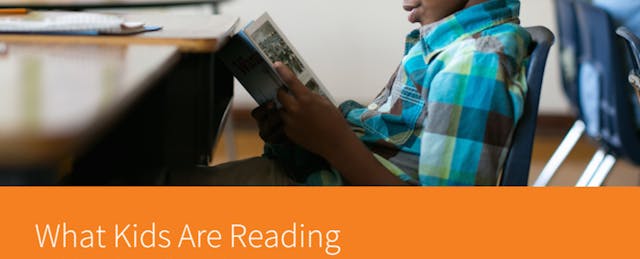Renaissance Learning, maker of Accelerated Reader 360 and Star Reading, has released its annual "What Kids Are Reading: And the Path to College and Careers" report, the eighth in the series. Renaissance analyzed 9.8 million students who read 334 million books on Renaissance’s Accelerated Reader 360 platform during the 2014-2015 school year. The results are grim. The average student is not meeting any college- and career-readiness reading standards.
The report broke down its measurements into three categories: time spent reading—a measurement for exposure to new vocabulary—nonfiction reading and interaction with complex texts. According to Eric Stickney, Director of Educational Research at Renaissance, the company focused on those three areas to weigh how reading habits align with new state standards and tests like the Smarter Balanced Assessments. The report also features lists of the most popular fiction books and nonfiction articles by grade. The overall emphasis, Stickney said, was to assess the effects reading had on achievement.
The connection between time spent reading and meeting the standards is direct. It doesn’t take much: 66 percent of students who read 15 or more minutes reading per day met standards. By contrast, only 39 percent of those who spent less than 15 minutes reading every day.
The NAEP, which released its disheartening national reading scores last month, recommends in its reading framework that nonfiction should be 50 percent of reading in fourth grade, 55 percent in eighth grade and 70 percent in twelfth. (That nonfiction heavy stack most closely reflects an adult’s reading diet, notes the report.) No state has a reading curriculum that consists of more than 29 percent nonfiction, though Stickney said nonfiction is on the rise nationwide. The states with the lowest percentage—New Hampshire, Rhode Island, Massachusetts and Nebraska—teach only 16 percent nonfiction. Girls trail boys in nonfiction reading. The integration of nonfiction articles is a recent initiative for Accelerated Reader as well, and nonfiction’s ability to bridge the gap between students and their standards remains to be seen.
When evaluating the complexity of texts, Renaissance’s experts examine the length of sentence and the difficulty level of vocabulary used as measured by the ATOS Readability Guide. For example, the most popular nonfiction article in grades one through three, “Dog Is a Hero for Warning Deaf Boy About Fire,” written by the Associated Press, reads at a 3.9 difficulty. All of Renaissance’s most complex fictional texts are more than a hundred years old.
A recognizable instance: Renaissance’s experts rate the New York Times Bestseller list poorly. The average fiction on the Times' list registers a 5.7 difficulty rating, suitable for the fifth grade. Nonfiction from the Times list, averages 7.7.
Mirroring the bestseller list, the most popular nonfiction among students is largely sensational and below the reading level appropriate for their grades. Stickney attributes this to self-selection: when students choose their reading materials, they frequently pick simple, easily digestible stories. This past year, only nine percent of students in grades 9 to 12 read a book with a difficulty of 9.0 or higher. Stickney says the difficulty of the texts chosen by students has not changed in recent years.
To ameliorate the students' shortcomings, Renaissance recommends a direct tactic: Read more, especially more nonfiction books. “Teachers can assign reading, but they can’t assume that it will happen at home,” Stickney says. “Classes need to set aside time in class to read with a teacher’s guidance. I don’t know of any shortcuts besides simply reading more.” One path to promote reading in class, Stickney notes, is for teachers to assign nonfiction articles (rather than longer books).
Renaissance is sharing the data from its research via learnalytics.com. Available data includes the most popular books by state, percent of curriculum that is nonfiction and words read. Users can view the latter two by grade level and by gender.
Despite the overall negative findings of What Kids Are Reading, Stickney remains optimistic. He said these numbers on student reading and postsecondary readiness have not moved in the past several years, but he also thinks that change in education takes time. He believes in the impact that daily reading can have on performance.


